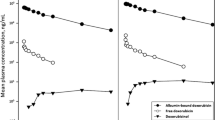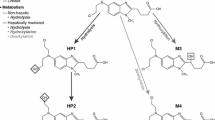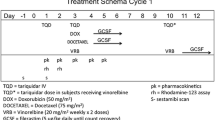Summary
Although a number of investigators have established that mitoxantrone (Novantrone®; dihydroxyanthracenedione) inhibits RNA and DNA synthesis and intercalates with DNA in vitro, its exact mechanism of action is unclear. Mitoxantrone is structurally related to a series of substituted anthraquinones and has features known to be essential for DNA intercalation; however, we have determined recently that mitoxantrone binds DNA in intact L1210 leukemia cells by a non-intercalative, electrostatic interaction and induces both protein associated and non-protein associated DNA strand scissions. The difference between mitoxantrone and doxorubicin with respect to their interactions with DNA could account for their relative lack of cross-resistance in the treatment of lymphoma and acute leukemia.
Distribution and half-life data provide a pharmacological rationale for the use of mitoxantrone on an intermittent dosing schedule. Considerable evidence exists to suggest that mitoxantrone undergoes extensive metabolism, probably in the liver. Preliminary data show that abnormal liver function leads to decreased rates of total body mitoxantrone clearance, suggesting a possible need for dose reduction in patients with severe liver dysfunction. The most important route of mitoxantrone elimination appears to be fecal. Because of the relatively low urinary excretion it is unlikely that the standard drug dose must be reduced in the presence of compromised renal function.
Similar content being viewed by others
References
Yap H-Y, Blumenshein GR, Schell FC, Buzdar A, Valdivieso M, Bodey GP: Dihydroxyanthracenedione: a promising new drug in the treatment of metastatic breast cancer. Ann Int Med 95:694–697, 1981
Stuart-Harris RC, Smith IE: Mitoxantrone: a phase II study in the treatment of patients with advanced breast carcinoma and other solid tumors. Cancer Chemother Pharmacol 8:179–182, 1982
Estey EH, Keating MJ, McCredie KB, Bodey GP, Freireich EJ: Phase II trial of dihydroxyanthracenedione in acute leukemia. Proc Am Assoc Cancer Res 23:113, 1982
Van Echo DA, Shulman PN, Ferrari A, Budman D, Markus SD, Wiernik PH: A phase II trial of mitoxantrone (DHAD, NSC 301739) in adult acute leukemia (AL). Proc 18th Ann Meet Am Soc Clin Oncol, St Louis, 1982
Coltman CA Jr, McDaniel TM, Balcerzak SP, Morrison FS, Von Hoff DD: Mitoxantrone hydrochloride (NSC-310739) in lymphoma. Invest New Drugs 1:65–70, 1983
Dukart G: American Cyanamid Company, Pearl River, New York, personal communication, August, 1984
Johnson RK, Broome MG, Howard WS, Evans SF, Pritchard DF: Experimental therapeutic and biochemical studies of anthracenedione derivatives. In M Rozencweig, DD Von Hoff and MJ Stagnet (eds.): New Anticancer Drugs: Mitoxantrone and Bisantrene. Raven Press, New York, 1983, pp 1–28
Plumbridge TW, Knight V, Patel KL, Braun JR: Mechanism of DNA-binding of some aminoalkylamino-derivatives of anthraquinone and naphthacenequinone. J Pharmacol 32:78–80, 1980
Kaupscinski J, Darzynkiewicz Z, Traganos F, Melamed MR: Interactions of a new agent, 1,4-dihydroxy-5,8,-bis ((2-((2-hydroxyethyl) amino)-ethyl) amino)-9, 10-anthracenedione, with nucleic acids. Biochem Pharmacol 30:234–240, 1981
Durr FE, Wallace RE, Citarella RV: Molecular and biochemical pharmacology of mitoxantrone. Cancer Treat Rev 10 (Suppl B):3–11, 1983
Foye WG, Vajragupta O, Sengupta SK: DNA-binding specificity and RNA polymerase inhibitory activity of bis(aminoalkyl)anthraquinones and bis(methylthio)vinylquinone iodides. J Pharm Sci 71:253–257, 1982
Lown JW, Hanstock CC, Bradley RD, Scraba DG: Interactions of the antitumor agents, mitoxantrone and bisantrene with deoxyribonucleic acids studied by electron microscopy. Molec Pharmacol 25:178–184, 1984
Bowden GT, Peng Y-M, Alberts DS: Comparative molecular pharmacology of the anthracene anticancer drugs bisantrene and mitoxantrone (Abstract 1171). Proc Am Assoc Cancer Res 75, 1984
Neidhart J, Stabus A, Young D, Malspeis L: Pharmacokinetic studies of dihydroxyanthracenedione (DHAD, NSC 301739) with clinical correlations (Abstract 121). Proc Am Assoc Cancer Res 72, 1981
Savaraj N, Lu K, Manuel V, Loo TL: Pharmacology of mitoxantrone in cancer patients. Cancer Chemother Pharmacol 8:113–117, 1982
Savaraj N, Lu K, Valdivieso M, Burgess M, Umsawadi T, Benjamin RS, Loo TL: Clinical kinetics of 1,4-dihydroxy-5, 8-bis((2-((2-hydroxyethyl)amino)ethyl)amino)-9, 10-anthracenedione. Clin Pharmacol Ther 31:312–316, 1982
Nelson EM, Tewey KM, Liu LF: Mechanism of antitumor drug action: poisoning of mammalian DNA topoisomerase II on DNA by 4′-(9-acridinylamino)-methanesulfon-manisidide. Proc Natl Acad Sci 81:1361–1365, 1984
Tewey KM, Chen GL, Nelson EM, Liu LF: Intercalative antitumor drugs interfere with the breakage-reunion reaction of mammalian DNA topoisomerase II. J Biol Chem 259:9182–9187, 1984
Tewey KM, Rowe TC, Yang L, Halligan BD, Liu LF: Adriamycin-induced DNA damage is mediated by mammalian DNA topoisomerase II (to be submitted, 1984)
Mattern MR, Painter RB: Dependence of mammalian DNA replication on DNA supercoiling. I. Effects of ethidium bromide on DNA synthesis in permeable Chinese hamster ovary cells. Biochim Biophys Acta 563:293–305, 1979
Ross WE, Glaubiger DF, Kohn KW: Protein associated DNA breaks in cells treated with Adriamycin or ellipticine. Biochim Biophys Acta 519:23–30, 1980
Bradley MO, Kohn KW: X-ray induced DNA double strand break production and repair in mammalian cells as measured by neutral filter elution. Nucl Acid Res 7: 793–804, 1979
McPherson I, Montagnier L: Agar suspension culture for the selective assay of cells transformed by polyoma virus. Virology 23:291–294, 1964
Bowden GT, Garcia D, Peng Y-M, Alberts DS: Molecular pharmacology of the anthracycline drug 9, 10-anthracenedicarboxaldehyde bis ((4,5-dihydro-1H-imidazol-2-yl)hydrazone)dihydrochloride (CL 216,942). Cancer Res 43: 2660–2665, 1982
Peng Y-M, Ormberg D, Alberts DS, Davis TP: Improved high performance liquid chromatography of the new antineoplastic agents bisantrene and mitoxantrone. J Chromatogr 233:235–247, 1982
Alberts DS, Peng Y-M, Leigh S, Davis TP, Woodward DL: Disposition of mitoxantrone in patients. Cancer Treat Rep 10 (Suppl):23–27, 1983
Woodward D: American Cyanamid Company, Pearl River, New York, personal communication, 1983
Ehninger G, Proksch B, Hartmann F, Garther H-V, Wilms K: Mitoxantrone metabolism in the isolated perfused rat liver. Cancer Chemother Pharmacol 12:50–52, 1984
Author information
Authors and Affiliations
Rights and permissions
About this article
Cite this article
Alberts, D.S., Peng, Y.M., Bowden, G.T. et al. Pharmacology of mitoxantrone: mode of action and pharmacokinetics. Invest New Drugs 3, 101–107 (1985). https://doi.org/10.1007/BF00174156
Issue Date:
DOI: https://doi.org/10.1007/BF00174156




